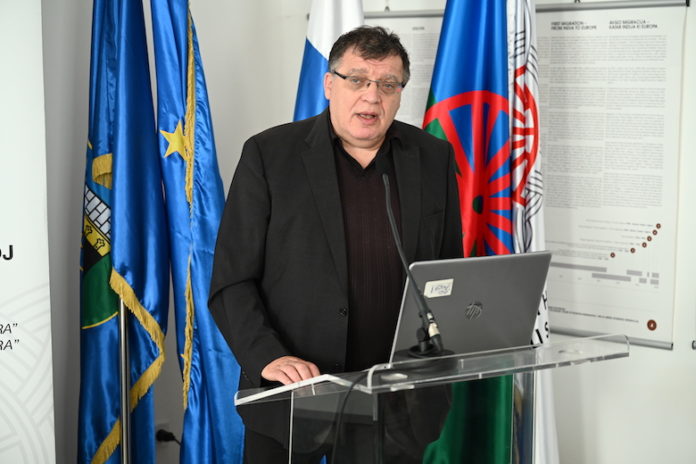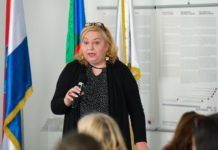Gerhard Baumgartner is an Austrian journalist and historian who, among other things, worked until quite recently as the head of research at the Documentation Center of Austrian Resistance. His research is focused on the following areas: resistance and persecution during the period 1938–1945, the history of persecution of Roma and Sinti, Austria’s handling of its Nazi past, and the history of national minorities in the Burgenland. This year Croatia holds the presidency of the IHRA, and Baumgartner was the participant in “The Second International Conference on the Genocide of the Roma”.
As an introduction, what was the motivation for you to devote your career to the questions of the Roma and Sinti communities?
I didn’t start with researching the Roma and Sinti community. Actually, I started out by researching minorities because I come from a minority myself. Most members of my family are Hungarian-speaking and I started with this. Then you move from one minority to the next: you write something about Hungarians in Burgenland and Croatians in Burgenland, then you realize there are also a lot of Roma, so I started to deal with that as well. That was maybe when I was 25, I was still a student. That was very early, there were not many people doing it. I knew some Roma from school who went to school with me and who were from the neighboring village. But I didn’t really know so much about their history for quite a long time. A little later on, when I finished university, I started to read and research more and more. Slowly, I became one of the few people who knew something about this topic. And that’s how it happened.
At the end of the 90s, there was a state commission called the Austrian Historians’ Commission which was created to research once again all the persecution during the Nazi period. They were looking for somebody who knew about the Roma and knew about Burgenland, and I was already involved in one project about Burgenland, particularly about the confiscation of Jewish property – this is one of the few other topics I really know something about – and then they said ‘Oh, if you are doing Burgenland and confiscation, you can also do the Roma.’ That was a really big project for many years.
So, from all this also came the motivation for you to write the book The Burgenland Roma. From 1945 to 2000 in 2004. What is the current situation with Roma in Burgenland and in Austria in general? Is it progressing towards something better?
The motivation for writing this book about the Roma was that there were a lot of, say, stories, but there were very few hard facts. This is what we tried to establish – how big was the group really, how many people could there be, how were they living, what we know, etc. We came to quite surprising findings. One was that from the Roma that had lived in Burgenland before the war, maybe 9,000 people, only 10% survived. If you calculate this with a population in the year 2000, there could be maybe 2 000-3 000, maximum 5 000 people who could claim that they were descendants of these survivors. This was the community that was officially recognized as the minority of Austrian Roma.
The situation in the first decades after the war was horrible. They were very poor, they got very few and very little compensation for the time when they were in concentration camps or, mostly, in work camps, and they actually lost all property that they had. The survivors very often didn’t know that there was maybe some property. We had a case where in one village a new football field was being built. They realized that the land belonged to ten different Roma who were not alive anymore. When they started to look at who these people were and if there were some kind of descendants who would inherit it, they discovered that a woman in the next village would inherit everything because she was the only living relative to all these people. Neither the woman knew something about this property nor did the people in the village know that it was like this. This kind of case was quite common at the time.
So, most of these people were poor, they were not allowed to go to school, and the survivors could not read and write. Their children also were doing very badly in school. They spoke Romanes, they didn’t speak German, they came to school, nobody could help them at home with the homework, so the school authorities very quickly put them into special classes for mentally handicapped children. There was even a commission by the Vatican – the Vatican has what is called the Roma Mission – they were complaining about this to the Austrian state in the 1950s several times, but nobody cared, nobody wanted or could do anything about it. Therefore, society was producing these people who were coming out of school and who also could not read and write, they had no qualifications, and they had no chance on the job market. It was a complete catastrophe.
It became a little bit better in the 1980s because there was a lot of interest in minorities in Austria. It had nothing to do with Roma. The general public realized that there were some recognized minorities, like Croatians of Burgenland, or the Slovenians in Carinthia, or Hungarians in Burgenland, or the Czechs and Slovaks – but the Roma were not recognized. There was a kind of campaign to help them. That started very slowly. At the end of the 80s and the beginning of the 90s, Roma activists and some people from NGOs helped Roma set up some Roma organizations. It became clear that very soon they would be recognized as an ethnic minority because Austria wanted to join the European Union. This was a human rights issue.
At the same time, Austria had a very bad reputation. Before that, there was a so-called Waldheim scandal. Waldheim was the secretary-general of the United Nations. Then it turned out that Waldheim had been a Nazi soldier in the Balkans. But he had told nobody. He presented his biography in, I don’t know, 6, 7, or 8 updated forms whenever they found something out. He was all over, in Bosnia, in Greece, here and there with the Nazi military leadership and he pretended to know nothing. That was very bad for the Austrian reputation.
About the Burgenland Roma community – 5,000 people is a very small community – if they recognize them it doesn’t cost the world. The government pretty quickly recognized Roma in 1993, just before they joined the European Union. They didn’t really think very carefully about this because in the meantime there was not only 5 000 Roma from the Burgenland, but through the migration of Gastarbeiter, there were about 50 000 Roma living in Vienna, from Bosnia, Serbia, shortly put, former Yugoslavia. They were not recognized, the other ones were recognized – this small group got some financial help from the state, but the other group did not get anything. It was a big chaos and it created a lot of tensions.
In the mid-90s there was an event that represented some kind of a turning point in the attitude of Austrian society and government towards the Roma. Could you tell me a bit more about it?
Yes, something very bad happened. In 1995 there was a bomb attack on the Roma settlement in Oberwart in Burgenland. There was a big Roma community even after 1945. The bomb attack killed four people. A neo-Nazi from Styria put a sign in the middle of the road in front of the Roma settlement saying ‘Roma go back to India’. Four young men touched the road sign. In the pipe that was holding the sign, there was a bomb. All four were killed.
This was a big turning point because, for the first time, all of Austria was in solidarity with the Roma. They were not the persecutors anymore. For the funeral, the whole government came. Ten thousand people attended it. The government realized that they must do something and they started a lot of programs. The best one, I think, was the program for extracurriculum education, which means that Roma children could go to school in the afternoon, they would get a meal and somebody would help them with the homework, which their parents could not do. In ten years, school careers or education careers changed completely. In ten years, you could see that people were going to gymnasiums, some were having A levels, and some were going to university. Today we have Roma in all positions, from diplomats down. For the first time, Austria learned there are Roma in Austria and what they look like and that they are not half-naked people wandering around.
Also, there were symbolic things. The Austrian government took the leaders of the Roma organizations everywhere after this bomb attack. If there was the opening of the Salzburg festival, one of the most expensive festivals for classical music, there was the prime minister and next to him there was the head of the Roma community as a guest. In the opera, there was the president of the republic and next to him in the first row, there was the president of the Roma community with his wife. They did this for a couple of years. It did a lot for the general acceptance and has changed the perception a lot. I think that discrimination today is not as bad as it used to be. There is still racism and there is still sort of prejudice and people still say that they don’t want Roma as their neighbors, but most of the time they don’t know. That is very interesting. When they realize, they say ‘Really, you are a Gypsy. I didn’t know. You are a normal person.’
What is also very interesting, we have Roma in every political party. We have them in the green party, in the social democratic party, in the conservative party, and even in the FPÖ, the liberal, so the right-wing party has a Roma representative. A little bit strange but actually quite a normal thing.
I would like to ask you something about your project Roma Sinti Genocide. You work a lot on producing materials that are available to teachers who work with Roma. Can you please tell me something more about that project of putting valuable materials on the Internet so that they are available to everyone, especially to teachers? What was the motivation for doing it?
Within IHRA, there is a workgroup on the Roma genocide. I joined that in 2005, I think, right at the beginning. I realized that most of the people from other countries, even if they were in this working group, had basically no idea. What we needed was a sort of quick way to get basic information. The first thing that we did was organizing the conference but with representatives of the Roma organizations from most of the countries, especially in central Europe. We asked them ‘What do you think that has to be on this page?’ The interesting thing was that they all said ‘The most important thing is that we want to show the life of Roma before the persecution, before the Nazis came and before fascists came in the different countries.’ Then we built the homepage, which still exists – it is being updated right now and, at the moment, it has fourteen different languages. IHRA has been financing that.
The idea was that you create a worksheet so that the teacher, if he or she wants to use it, can download it and it’s ready for use. You have a photograph, you have a very small text, you have a question for the pupils and you have a task for the pupils. On the website, there are maps and you can see the different camps. This has worked quite well. The idea was to get a quick overview. For example, if you go to the page of the persecution, you can see what the persecution means – you lose your job because of racism, you have to accept forced labour, they arrest you and put you in a work camp, maybe they even sterilize you. For each of these points, and usually there are 8 to 10 for one chapter, there is a worksheet. Altogether, there are 70 worksheets.
We try to find examples from all over Europe. In Croatia, there was a massacre in Hrastina. It’s an interesting story because that was a Sinti family from Germany who before the war was quite rich. They were running a cinema or even several cinemas. They fled to Yugoslavia. We had a mistake in the worksheet because we thought that they were killed by the SS in 1944, which is not true. New research that Ivo Pilar Institute and Danijel Vojak are doing shows that local Ustaše killed them. So, our worksheets are being updated all the time.
If you want to get a quick overview, also as a journalist, you can look, for example, which were the most important camps or which was the first camp. You will realize that the first camp for Roma was in Switzerland even before the First World War. In the First World War, there were Roma camps in France, in Austria, Germany. You can find a lot of interesting things – that there were a lot of persecution before the Nazis. And with the Nazis, it became very deadly. Also, you can find out what happened afterward, whether they were recognized as victims or not. Some Roma fought in the German army because they were drafted and later it was discovered that they were so-called Gypsies, so they were kicked out and taken to Auschwitz. Some were in the resistance, some were Partisans, some fought in the French army against the Nazis. There is also a section about survivors. Every 5, 6, or 7 years we try to update with the most important information that we have, which is of course expensive because you have to do it in fourteen languages.
Do you know how much the Austrian schoolchildren learn about the fate of the Roma? In Croatia, children learn almost nothing. In history textbooks, Roma are usually mentioned only when the Second World War genocide is mentioned, and even then only in one sentence. That’s the only information the schoolchildren get about the Roma history. What is the situation in Austria?
The situation was very good in the 80s, 90s, 2000s, largely because of a very good novel based on a true story. The novel, Farewell to Sidonie by Erich Hackl, is about a 12-year-old fostered child. She grows up in a family of workmen in the town of Steyr. The member of the criminal police finds out that her biological mother is a so-called Gypsy. He somehow makes it to get this child into Auschwitz. She is called Sidonie Adlesburg. And she died in Auschwitz.
The novel became very popular, especially after the bomb attack. For at least 15 or 20 years, every child in school read this book. Now, this is no longer the case. I can see that not all the children know who Sidonie was. It did a lot to popularize the knowledge about the persecution of Roma. In many, many schools it is still a very popular book. That is actually a unique case, I don’t think there is another country where this is the case. It’s a little bit like in Holland where everybody knows Anne Frank.











